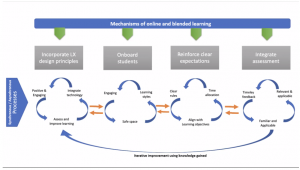 In this reflection I will reflect on a course that was not aimed as an online learning course, but that I had to give as an online course in Zoom during the pandemic. I will do this in relation to what could have been better. I will do this reflection in relation to Robin Key’s webinar and book Thriving Online (????) and Holly S. Fiock’s “Designing a Community of Inquiry in Online Courses” (2020). During this thinking, I will reflect on synchronous and asynchronous activities, as well as social, cognitive, and teacher presence from the “Community of Inquiry Blended Learning Evaluation” in Cleveland-Innes and Wilton’s Guide to Blended Learning (2018). In addition, I will do this related to the model created in the PBL4 group.
In this reflection I will reflect on a course that was not aimed as an online learning course, but that I had to give as an online course in Zoom during the pandemic. I will do this in relation to what could have been better. I will do this reflection in relation to Robin Key’s webinar and book Thriving Online (????) and Holly S. Fiock’s “Designing a Community of Inquiry in Online Courses” (2020). During this thinking, I will reflect on synchronous and asynchronous activities, as well as social, cognitive, and teacher presence from the “Community of Inquiry Blended Learning Evaluation” in Cleveland-Innes and Wilton’s Guide to Blended Learning (2018). In addition, I will do this related to the model created in the PBL4 group.
The only tool used were zoom and the students were about fifteen at the start and I ended up assessing four written examination assignments. The University was closed so I was teaching from home and the students likewise took part from their homes. It was the autumn semester, and it gradually went darker and darker outside our windows, and the course schedule was 3.15 to 6.00 PM. At the end of the semester, it had gotten harder and harder to see each other in the zoom-squares since we didn’t even discuss the light issue. Also, the students quickly switched of their microphones, so it was very dark–both literally and figuratively. My voice was speaking, as it seemed, out into an empty void. Of course, it is important to note that the switch to online learning was prompted without discussions or fist having taken any courses (like ONL231). Both me and the students learned the zoom tool together during the course and we found our way to breakout rooms for the discussion sessions planed for the campus course version.
The lectures, after an introduction session, had the structure of an initial brief lecture, group discussions about texts, phenomena or projects discussed, large group discussion, and a final talk/lecture linking on the themes they brought to the table with their projects and the theme of the session.
If I could do this course online now, especially after ONL231, I would, e.g., consider the following aspects:
Before the course: The planning before the course will result in a plan for technology matters as well as a student support strategy including a communication plan to promote cognitive presence (CP and TP) (Key and Hunter 2022) and setting the climate (SP and TP) (Fiock 2020). Creating a clear image of the course’s big picture (Webinar by Key 2023). Perhaps also make videos of the course outline and the learning outcomes (Key and Hunter 2022).
Introduction week: Introduction to different tools, besides just discussing in breakout rooms. In later courses I have worked with interactive whiteboards, and that I would use also in this course (Key and Hunter 2022). Anticipation will be asked for asynchronously, as a private work (Fiocki 2020) and discussed synchronously during the introduction week and the course outline presented and reflected upon (CP) for the purpose of integration (Fiocki 2020). Including the plan for interaction and collaboration. Furthermore, formative reflections will be encouraged (Key and Hunter 2022).
During sessions: Engaging students’ own experiences and focusing on problems students have met in their world (SP). Doing this in groups with others this will also create a cognitive presence (CP); lessons learned through others. Constructive teacher feedback is also relevant here, enhancing both the cognitive and teacher presence. As a teacher that would also include translations of the literature to the students’ experiences (TP) (Key and Hunter 2022 see also Cleveland-Innes and Wilton 2018). The students will work with projects they create themselves, just as in the campus course, and work during synchronous discussion sessions with others (CP) and in synchronous supervision session (TP= to link the literature to their work.
Assessment: Besides having peer-review session, oral synchronous discussions will also be part of assessing and examination, giving students a chance at learning during the examination. Also, this is thought to complement written handed in assignments supporting the students not to rely only on AI. Feedback will be given during the course linked to assignments (TP)–acknowledging also emotional presence the students experience in discussing and talking about the assignments (EP) (Cleveland-Innes and Wilton 2018).
Overall, I would work with Fiocki’s (2020) instructional activities, based on seven principles for community of Inquiry: Student-teacher contact, Cooperation among students, Active learning, Prompt feedback, Time on task, Communicate high expectations, and Respect diverse ways of learning (Fiock 2020). Also, in our PBL4-group discussion, we created a model for mechanism of online and blended learning that I would use. In this model, the process of the course meets mechanisms. The four mechanism we detected were (and in brackets are the parts of the process which could be both synchronous and asynchronous)
1) Incorporate LX design principles (positive and engaging, integrate technology, and assess and improve learning)
2) Onboard students (engaging, learning styles and safe space)
3) Reinforce clear expectations (clear roles, time allocation, and aligning with learning objectives)
4) Integrate assessment (timely feedback, relevant and applicable, and familiar and applicable)
To sum up, these matters I think would create cognitive relevance, engagement, and a sense of belonging in the course.
Literature
Cleveland-Innes, M. & Wilton, D. (2018) “Community of Inquiry Blended Learning Evaluation” (2018),. Guide to Blended Learning. Burnaby: Commonwealth of Learning. Appendix 1. p.74-77. http://oasis.col.org/bitstream/handle/11599/3095/2018_Cleveland-InnesWilton_Guide-to-Blended-Learning.pdf?sequence=1&isAllowed=y
Fiock (2020), “Designing a Community of Inquiry in Online Courses”, The International Review of Research in Open and Distributed Learning. 21/1), 135–153.
Key, R (2023) “Thriving online in Higher Education”, webinar in ONL231. https://docs.google.com/presentation/d/13LHm5afdOYzzTimFbFetYnvXLdlxXpcGZaGQKviHXMI/edit#slide=id.p Dowloaded 230601.
Key, R. and Hunter, W. (2022) “Thriving Online: A Guide for Busy Educators,” Ontario Tech University. DOI:10.51357/TMSM9420
https://www.researchgate.net/publication/359044200_Thriving_Online_A_Guide_for_Busy_Educators Downloaded 230601.

One Comment
Thank you Anna-Lena for this very structured reflection! Isn’t it amazing what we have learned from the pandemic and the fact that we were all forced online. Using the COI framework also really makes us think about presence: are we in a place or a space?
Which presence becomes more (and less) important in this setting?